Solar Panels Lakeland:Mono Solar Panel 80w A Grade with Cheapest Price
- Loading Port:
- Tianjin
- Payment Terms:
- TT OR LC
- Min Order Qty:
- 100 watt
- Supply Capability:
- 1000 watt/month
OKorder Service Pledge
OKorder Financial Service
You Might Also Like
Specification
Mono Solar Panel 80W A Grade with Cheapest Price
product description
A photovoltaic (in short PV) module is a packaged, connected assembly of typically 6×10 solar cells. Solar Photovoltaic panels constitute the solar array of a photovoltaic system that generates and supplies solar electricity in commercial and residential applications. Each module is rated by its DC output power under standard test conditions, and typically ranges from 100 to 365 watts. The efficiency of a module determines the area of a module given the same rated output – an 8% efficient 230 watt module will have twice the area of a 16% efficient 230 watt module. There are a few solar panels available that are exceeding 19% efficiency. A single solar module can produce only a limited amount of power; most installations contain multiple modules. A photovoltaic system typically includes a panel or an array of solar modules, a solar inverter, and sometimes a battery and/or solar tracker and interconnection wiring.

Feature
The modules use high-quality imported polycrystalline or Polycrystalline solar panel;
Enclosed by high-rigidity tempered glass, with excellent light transmittance and output performance;
Surface treated with reflection-reducing process, increasing the light absorption.
Back sealed with anti-aging EVA, resistant from moisture and corrosion.
The efficiency of our Polycrystalline solar cell is over 17%, and polycrystalline panel is over 16%. We stipulate, the allowance of each panel’s rated power has to be positive. Each panel is strictly tested before leaving the factory.
Our solar panel is designed with a lifetime of 25 years, and guaranteed that the power decline less than 10% within 10 years, and 20% within 20 years.
Packaging
28pcs into one box 48pcs into one pallet.
Delivery
20 days after received full payment
Payment term
LC&TT
- Q: i am looking at installing some solar panels and a wind turbine for electricity.has anybody got one of these and how much do they save you?thanks
- Both wind and solar take many years to break even economically, even with government subsidies (Using someones hard-earned tax dollars for your use). If purchased and installed with your own money, they will never pay for themselves because they will need replacement long before you save enough to pay the cost.
- Q: What things can a solar panel power?
- With the right equipment anything that requires electricity. I have been living on solar power for 6 years now.
- Q: I have a home in Manchester Tn and we have been slowly remodeling the home. It is about 200 sq ft of living space. Our normal electric bill is about 50 a month. We would like to add some solar panels to the home to help reduce the amount of the bill. How many panels do I need and what would be the cost? I am not trying to go completely of the grid but I would like to start somewhere and maybe over the years be able to add. What is your recommendation for a reasonable cost of under 2 to 3 k??
- Ok, well there are also other alternative energy sources, too, besides solar. There is tidal (but you need an ocean :] ), hydroelectric (river, stream, etc.), biomass/biofuels (burning garabage), geothermal (from within the earth, pipes in the earth), wind (windmills, wind, the sun to get wind), and there are others that don't come to mind. Solar energy would cost alot to be installed, and it would take up alot of space, but once installed it pays for itself and uses little to no labor. They all have positives and negatives. All of these are clean and renewable. Here are some sites that my teacher/professor gave us (we just ended alternative energy lesson.) Well I hoped this helped!
- Q: Do they really save energy? Cut or almost eliminate your electricity bill, if so, how much?Do they have a reserve unit to save electricity that I don't use, to use when the sun is not out?Can it produce enough electricity to cool a house and keep lights and appliances runningLastly, how much are the panels are running for.
- It Can produce enough energy to run fans and yes keep the house cool. And if you also want to make one try it out. Good luck and save energy
- Q: Are there any government incentives or rebates for installing solar panels?
- Yes, there are various government incentives and rebates available for installing solar panels. These incentives can include federal tax credits, state and local grants, and utility rebates. These programs aim to encourage the adoption of renewable energy sources and can significantly offset the upfront costs of installing solar panels. It is advisable to check with local authorities and utilities to determine the specific incentives and rebates available in a particular area.
- Q: I would like to know how do you build a solar panel?
- At first, you will need about one square foot of thin copper plate, two alligator clips and short leads of wire, a wide mouth glass jar, tap water and salt. Cheers,
- Q: Why are they placed there? How come they aren't placed on the floor or window.My fiance and I are interested in putting solar panels on our new home. I was really curious and google wasn't giving me the answer. My roof is pretty small in our new house and I don't think it would fit there. Why is it usually placed there and is there another place? You will be chosen as best answer if you answer all my questions. Thanks in advance, and I would appreciate if nobody is rude. Otherwise, I will have to report abuse.
- The roof receives the most direct sunlight, and the more direct the sunlight the more electricity is produced. I've never seen solar panels located elsewhere on a house, but I have seen some placed in a yard or field.
- Q: How hard is it to install solar energy panels on your house? Is this a reasonable way to produce 00% of your house's energy? Is there any danger?
- Yes, but it is still very expensive at the moment. Look into solar leasing where you rent your roof to a company that installs and owns the panels and pays you a portion for surplus energy beyond your usage. I looked into going off the grid a couple years ago and based on our usual consumption it was going to take a $40,000 investment with a 0 year payback for panels, inverter, and storage batteries.
- Q: How do solar panels affect the overall carbon footprint of a building?
- Solar panels can significantly reduce the overall carbon footprint of a building. By harnessing clean and renewable energy from the sun, solar panels eliminate or greatly reduce the need for traditional fossil fuel-based electricity generation. This means lower emissions of greenhouse gases like carbon dioxide, which are major contributors to climate change. The use of solar panels helps to transition buildings towards a more sustainable and eco-friendly energy source, effectively reducing their carbon footprint.
- Q: Can solar panels be used in areas with limited space?
- Yes, solar panels can be used in areas with limited space. There are various options available, such as rooftop solar panels, solar canopies, or even solar panels integrated into building materials. These solutions are designed to maximize the utilization of limited space while still harnessing solar energy efficiently.
Send your message to us
Solar Panels Lakeland:Mono Solar Panel 80w A Grade with Cheapest Price
- Loading Port:
- Tianjin
- Payment Terms:
- TT OR LC
- Min Order Qty:
- 100 watt
- Supply Capability:
- 1000 watt/month
OKorder Service Pledge
OKorder Financial Service
Similar products
Hot products
Hot Searches
Related keywords


























